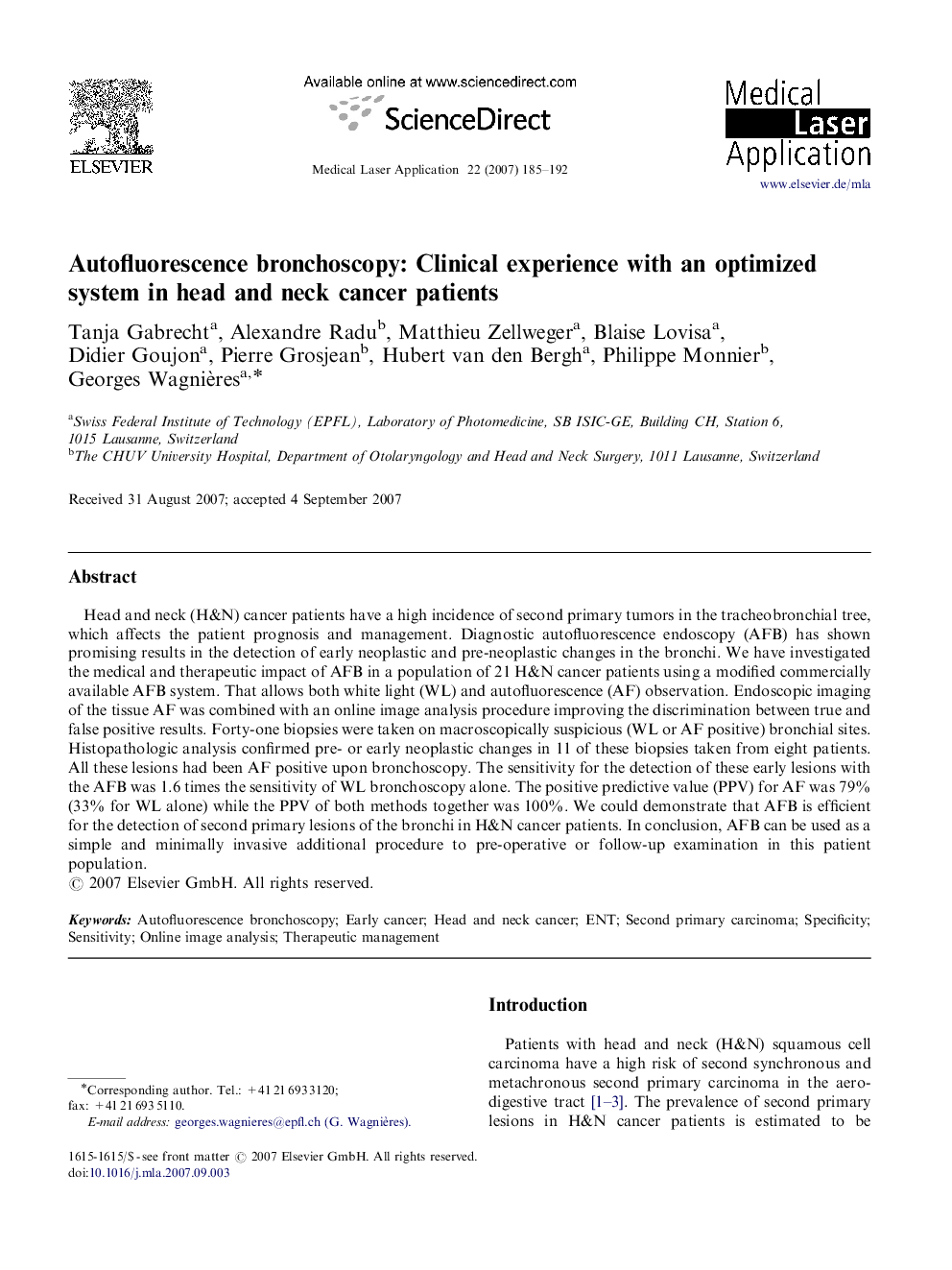| کد مقاله | کد نشریه | سال انتشار | مقاله انگلیسی | نسخه تمام متن |
|---|---|---|---|---|
| 2068440 | 1078301 | 2007 | 8 صفحه PDF | دانلود رایگان |

Head and neck (H&N) cancer patients have a high incidence of second primary tumors in the tracheobronchial tree, which affects the patient prognosis and management. Diagnostic autofluorescence endoscopy (AFB) has shown promising results in the detection of early neoplastic and pre-neoplastic changes in the bronchi. We have investigated the medical and therapeutic impact of AFB in a population of 21 H&N cancer patients using a modified commercially available AFB system. That allows both white light (WL) and autofluorescence (AF) observation. Endoscopic imaging of the tissue AF was combined with an online image analysis procedure improving the discrimination between true and false positive results. Forty-one biopsies were taken on macroscopically suspicious (WL or AF positive) bronchial sites. Histopathologic analysis confirmed pre- or early neoplastic changes in 11 of these biopsies taken from eight patients. All these lesions had been AF positive upon bronchoscopy. The sensitivity for the detection of these early lesions with the AFB was 1.6 times the sensitivity of WL bronchoscopy alone. The positive predictive value (PPV) for AF was 79% (33% for WL alone) while the PPV of both methods together was 100%. We could demonstrate that AFB is efficient for the detection of second primary lesions of the bronchi in H&N cancer patients. In conclusion, AFB can be used as a simple and minimally invasive additional procedure to pre-operative or follow-up examination in this patient population.
ZusammenfassungPatienten mit malignen Tumoren im Kopf- und Halsbereich haben ein stark erhöhtes Risiko, Zweit- und Mehrfachtumore, insbesondere im Respirationstrakt und in der Speiseröhre, zu entwickeln. Die Anwesenheit und der Charakter dieser Sekundärtumore beeinflussen stark die Prognose des Patienten und müssen im Therapieplan berücksichtigt werden. Diagnostische Autofluoreszenz-Bronchoskopie (AFB) hat vielversprechende Ergebnisse in der Detektion von Frühneoplasien und prä-neoplastischen Veränderungen der Bronchialschleimhaut gezeigt. Wir haben die medizinische und therapeutische Bedeutung von AFB in einer Population von 21 Kopf- und Hals-Krebspatienten untersucht. Die Studie wurde mit Hilfe eines abgewandelten kommerziell erhältlichen AFB Systems durchgeführt. Dieses System erlaubt sowohl die Durchführung von konventioneller Weisslicht- (WL) als auch von Autofluoreszenz-(AF)bronchoskopie. Die endoskopische Untersuchung der Gewebeautofluoreszenz wurde mit einem Echtzeitbildanalyseverfahren kombiniert, welches die Unterscheidung zwischen falsch und echt positiven Ergebnissen während der Untersuchung vereinfacht. Insgesamt wurden 41 Gewebeproben an makroskopisch verdächtigen (WL oder AF positiven) Stellen in den Bronchien entnommen. Histopathologische Untersuchungen bestätigten die Anwesenheit von früh- oder prä-neoplastischen Veränderungen in 11 Gewebeproben von 8 Patienten. Die Sensibilität von AFB für diese frühen Veränderungen der Schleimhaut war 1,6 mal höher als die Sensibilität der Weisslichtbronchoskopie alleine. Wir konnten zeigen, dass AFB eine effiziente Methode zur frühzeitigen Erkennung von Zweit- und Mehrfachtumoren im Respirationstrakt bei Patienten mit Kopf- und Hals-Krebs darstellt. Zusammenfassend lässt sich sagen, dass AFB als eine einfache und minimal invasive Ergänzung zur präoperativen Diagnosestellung und zur postthera- peutischen Nachkontrolle in dieser Patientengruppe verwendet werden kann.
ResúmenLos pacientes con cáncer de cabeza y cuello tienen una alta incidencia de segundos tumores primarios en el árbol traqueobronquial que afecta el pronóstico y tratamiento de estos pacientes. La broncoscopía autofluorescente de diagnóstico (AFB) ha demostrado resultados prometedores en la detección de cambios neoplásicos tempranos y pre-neoplásicos en los bronquios. Hemos investigado el impacto médico y terapéutico de la AFB en una población de 21 pacientes con cáncer de cuello y cabeza, usando un sistema AFB comercialmente disponible modificado que permite la observación de luz blanca (LB) y autofluorescente (AF). El monitoreo endoscópico del tejido autofluorescente fue combinado con un procedimiento online de análisis de la imágen mejorando así la discriminación entre positivos verdaderos y falsos positivos. 41 biopsias fueron tomadas en sitios bronquiales macroscópicamente sospechosos (positivos para LB o AF). Los análisis histopatológicos confirmaron cambios pre o neoplásicos tempranos en 11 de estas biopsias tomadas a partir de 8 pacientes. Todas estas lesiones habían presentado AF positiva en la broncoscopía. La sensibilidad para la detección de estas lesiones tempranas con el AFB fue 1,6 veces mayor que la sensibilidad de broncoscopía con luz blanca. El valor predictivo positivo (PPV) para la AF fue de 79% y sólo del 33% para la LB, mientras que el PPV de ambos métodos junto fue del 100%. Pudimos así demostrar que la AFB es eficiente para la detección de las segundas lesiones primarias de los bronquios en pacientes con cáncer de cuello y cabeza. En conclusión, la AFB puede ser utilizada como un procedimiento adicional simple y mínimamente invasivo en el examen pre-operatorio o en el seguimiento de estos pacientes.
Journal: Medical Laser Application - Volume 22, Issue 3, 20 December 2007, Pages 185–192